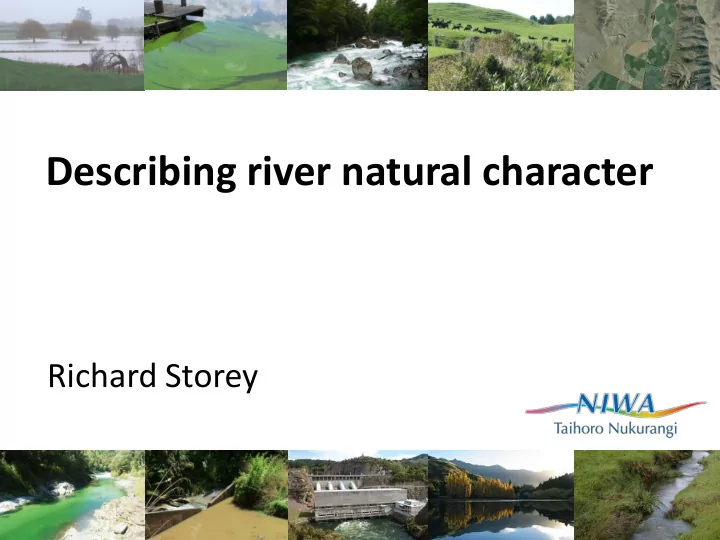

Describing river natural character Richard Storey
Natural Character attributes Identified by RWC Suggested for Bayesian Network Morphology (pool:riffle ratio, sinuosity, River shape: braidedness, sinuosity, bank condition) channel shrinkage, diversity of flow types (?), mechanical modifications Flow regime Baseflow (% of MALF) Visual clarity/Suspended sediment Visual clarity Macrophyte cover Encroaching vegetation Riparian index: vegetation amount Riparian vegetation extent Riparian index: vegetation type Riparian vegetation type Periphyton (algal) cover and biomass Periphyton biomass or % cover Sediment deposition Deposited fine sediment Primary senses (blind person test) Instream habitat Structures/mechanical modifications
Natural Character attributes Identified by RWC Suggested for Bayesian Network Morphology (pool:riffle ratio, sinuosity, River shape: braidedness, sinuosity, bank condition) channel shrinkage, diversity of flow types (?), mechanical modifications Flow regime Baseflow (% of MALF) Visual clarity/Suspended sediment Visual clarity Macrophyte cover Encroaching vegetation Riparian index: vegetation amount Riparian vegetation extent Riparian index: vegetation type Riparian vegetation type Periphyton (algal) cover and biomass Periphyton biomass or % cover Sediment deposition Deposited fine sediment Primary senses (blind person test) Instream habitat Structures/mechanical modifications
Encroaching vegetation
Discussion points • Any attributes missing? • Can any attributes be removed? Consider: • Attributes should be visual (Natural character is “ perceived ”). • As few attributes as possible • Attributes must relate strongly to values • Attributes should be only those that could change under the plan change • Attributes that affect a high proportion of the river network are more useful than those that have only local impact.
States of attributes Attribute State 1 State 2 State 3 State 4 braidedness low high R i v e r s h a p e sinuosity low high channel shrinkage low high Flow diversity low high mechanical ? ? modification ? ? baseflow water clarity 0 to 1.4 m 1.4 to 3.75 m 3.75 to 5 m > 5 m encroaching veg low high riparian veg extent low med high riparian veg type periphyton cover 0-50 mg/m 2 50-120 mg/m 2 120-200 mg/m 2 >200 mg/m 2 deposited sediment
Discussion points Attribute Issue Mechanical modifications to shape or appearance (for flood control) How can it be measured? Structures Riparian vegetation type What types to consider? e.g. exotic vs. native, tree vs. shrub What types would score high vs. low?
How to combine attributes? • Straight average? • Weighted average? What weights? • Other (e.g. minimum value)?
States of attributes Attribute Sub-attribute weight River shape braidedness sinuosity channel shrinkage flow diversity mechanical mod baseflow water clarity encroaching veg structures/mod riparian veg extent riparian veg type periphyton cover deposited sediment
Bayesian Network for examining effects on ecological values Richard Storey
Ecological attributes in the network Attribute measure States River birds Abundance or no. of species OK, not OK Periphyton (algae) Biomass (mg/m 2 ) Four NOF bands Cyanobacteria (toxic algae) % cover <20%, >20% Macroinvertebrate MCI units Four quality classes Community Index Native fish: taonga spp Abundance (% change from Decline, stable, (LF&SF eels, inanga, black present) increase flounder, mudfish, lamprey FW mussels, koura) Native fish: ecological Abundance (% change from Decline, stable, indicator (redfin bullies) present) increase Trout size & abundance Suitability for swimming OK, not OK Natural character Poor, med, good
Supporting attributes • Water quality: • clarity • Water temperature • Dissolved nutrients (N, P) • Dissolved oxygen • Suspended sediment • E. coli bacteria • River physical habitat • Deposited sediment • river shape, form • Flows: • Low flow • Flood magnitude and frequency
Scale of outcomes • Not location-specific • Mostly reach-based (100s or 1000s of metres) • Some “point” attributes • Usable at scale of Freshwater Management Unit (~6 administration points) • Note: all attributes relate to Ruamahanga River and main tributaries. • No lake, wetland or groundwater attributes • No small streams
Scenarios that could be modelled • New dam • Changes to water abstraction • Land use change • Riparian planting • Other on-farm mitigations • Changes to river works for flood management (e.g. beach raking) and gravel extraction
Recommend
More recommend